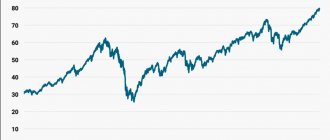Essence, types and examples
In the well-known theory of Keynesianism, investments and, above all, investment expenditures are an integral part of total household expenditures, along with government purchases and net exports of goods and services. Economists consider it the most volatile and dynamic component due to its dependence on many factors. If we take a deeper look at investments (functions, types, their meaning, methods of application), then we will have to go a little beyond the scope of this theory.
Investments in a narrow sense
From a financial point of view, the functions of investment are reduced to the investment of funds (assets) that are used in the process of production and economic activity. Economics treats investments as expenses of entities for the purpose of capital accumulation, providing for the creation of new capital and the replacement of worn-out funds. From this side, the main function of investment is to generate income. In other words, national economic entities invest part of their income in economic development so that it pays off and returns to them in an increased amount.
Entrepreneurs also consider investment as a business transaction for the acquisition of production and non-production assets and financial instruments in exchange for property or cash. At the same time, investment expenses can help increase capital or maintain it at the same sufficient level.
And although the share of investment expenditures in total national expenditures occupies a fifth, fluctuations in business activity and positive economic growth depend on them - all other things being equal, an increase in investment proportionally increases the gross domestic product.
Investor assets
Investors' assets are what generate monetary benefits and can be used to generate cash.
Stock
Shares are issued by companies to raise additional funds. These are securities that certify the investor’s right to:
- making a profit (dividends);
- participation in management;
- part of the property (in the amount of a share) in bankruptcy.
Preferred shares (prefactions) guarantee only the receipt of dividends, and in the event of liquidation of the enterprise they give a preferential right to compensation. Such shares do not provide the investor with voting rights.
Bonds
Bonds are debt securities. The investor provides loans to the state, regional and local authorities, and companies. Receives income in the form of interest.
Income can be paid:
- one-time (then this is the difference between the purchase and nominal value);
- regularly (coupon payments).
Real estate
Real estate is the favorite asset of the novice investor. But these are not only buildings and structures. According to the Civil Code of the Russian Federation, this is also:
- enterprises as a property complex;
- land;
- subsoil areas;
- isolated water bodies;
- perennial plantings, etc. - everything that is firmly connected to the ground, stands, is located inside or outside.
It is simply impossible to move an investment object without significant costs. For example, moving a pond means (simplified):
- create and approve a project;
- dig a pit, strengthen the bank;
- drain and bury the old pond.
From a legal point of view, real estate includes property to which rights are registered (property, lifelong ownership, easement, mortgage).
By the way, aircraft and sea vessels, inland navigation vessels, space objects (all subject to state registration) are classified as real estate - on earth these are “standing” objects. But money and securities - no.
Commodity assets
Investor's commodity assets include precious metals and stones, as well as commodities. Don’t be confused: if a person buys a batch of goods and then sells it, this is trade, not investment.
This also includes alternative investments: collectible wines, antiques, art objects.
Investment fund
The investment fund attracts funds from investors to co-finance investment projects. Through this asset, investment objects for which a private owner simply would not have enough funds become indirectly available.
mutual fund
A mutual investment fund is:
- a separate property complex transferred to a management company with the condition of combining it with the property of other investors;
- property received during the management process.
Ownership is confirmed by a security issued by the management company.
The main income of a mutual fund consists of the increase in the value of the share over time.
mutual fund
The investments of small investors form a mutual fund. Essentially, this is an investment portfolio formed by a professional manager. In addition, investments are distributed among a large number of objects, so the risk factor for a small investor is reduced.
Hedge fund
An investment asset for a select few, the task of which is to minimize risks at a specified return (or obtain maximum return at a given risk). A high entry fee and (often) proof of ownership are required.
ETF
Or Exchange Traded Fund. An investor invests in an exchange-traded fund by purchasing shares on an exchange.
Functions of investment in economics
From the definitions of investment it is clear that these processes can be carried out both at the state and at the private level of an economic entity, but ultimately it all comes down to improving the welfare of the state. This means that the functions that investments perform are designed to satisfy all interested parties: households, banks, enterprises, formal and informal institutions, associations, and the public sector. Let us highlight four key properties that make investment the cornerstone of macroeconomics:
- The distribution function is interpreted as follows: by choosing where to invest money or assets, an entrepreneur or the state contributes to the development of one industry more than another. Using an example, it looks like this: domestic ones cannot compete with foreign electronics and cars; it is more profitable for an entrepreneur to invest money in something else.
- Regulatory property: investments are made globally and affect related sectors of the economy. The new plant involves the construction of roads, a recreation center, the creation of new jobs, etc.
- Incentive: investing involves putting money towards improvement. Science, technology, and the level of education are optimized, and as a result, the quality of life and well-being of the country improves.
- Indicative: a property of investment that is closely related to the processes of increasing capital and maintaining the balance of an open economic system.
Having examined the theoretical aspects of the formation and functioning of investments, let us move on to their graphical display, which clearly shows how the consumption function, investment function, savings and consumption are interconnected on the scale of the economic system of the state.
Definition
Any function, mathematical or economic, is a dependence of the final result on one or many factors. Investment functions are also models in which the endogenous variable (the final result) is investment costs, and the exogenous variable is determined by the objectives of the study.
If there is only one independent variable, then the others are said to be “under other given conditions.” So, if investments are given as a function of income, this means that the bank interest rate and prices did not change significantly during this period.
The more independent variables, the higher the reliability of the model and its proximity to real economic conditions. The dynamics of changes in variables can be very different in different periods, and to simplify the problem, researchers select one or two main factors on which the functions of the investment will depend.
Relationship between investment and interest rate
Without exaggeration, we can say that the size of investments depends on the interest rate, while changes in other factors are taken over by the function of autonomous investments included in the multifactor model, which has the following form:
- I = Ia – d * r (1), where I – total investment costs; Ia – autonomous investment expenses; d – sensitivity of the investment to a decrease or increase in the rate, %; r – real interest rate.
The meaning of the interest rate is explained quite simply. Every businessman, before investing money in a risky enterprise (and 100% risk-free investments do not exist in principle), evaluates how much he can earn from it and how much he needs to spend for this. For large-scale investments, internal financial resources are often insufficient, and the entrepreneur is sent to a bank or non-bank financial organization, which demands a price for its services - that same percentage. The higher the bank's price, the lower the businessman's profit and the profit-to-cost ratio. As you know, maximizing profits from all types of activities is the ultimate goal of any enterprise.
A step-by-step guide to becoming a good investor from scratch
For a good investor, discipline and compliance with the law (regulations or rules) come first, and the absence of losses comes second. And only in third place is the profitability of the operation. Here are recommendations from successful investors to beginners:
- Study as much literature on investments, markets, instruments as possible. The direction of work will become clear (there is no need to initially focus on yachts, gold, factories with pipes);
- find specialized forums. On “branches” real people share their experiences;
- Don’t be lazy, open up the legislation. Ignorance of the laws does not exempt you from responsibility;
- remember: the higher the risk, the higher the return. So make a plan and start with low-risk operations;
- determine the limit amount of losses;
- Having collected sufficient capital, begin to separate areas of investment (investment portfolio);
- monitor the market situation.
The main thing is to learn to think like an investor. Look around, assessing opportunities for profit.
Other examples
You need to understand that there are a huge number of ways to use such a tool as investment. The income function, for example, is constructed taking into account a given financial transaction. In addition to loans and non-bank loans for the purchase of equipment, machinery or financial instruments, an entrepreneur can spend money from his own pocket. In an enterprise, this is the part of the profit that remains after paying taxes and other planned deductions. In this case, fluctuations in the final amount of investment expenses will directly depend on changes in the operating income function of the enterprise. As profits and their consumed portion grow, investments increase. Losses increase—investment is reduced or curtailed indefinitely. The investment function then has a form that is significantly different from the previous example, since we are adding total income.
The marginal propensity to invest is a multiplier that shows by what amount investment increases or decreases when a unit of income changes. The higher the multiplier value, the more risk-averse the entrepreneur is. If you win, investments can be returned many times over, and if you lose, they can lead to huge losses and even bankruptcy.
Not only macroeconomics
The microeconomy also needs cash injections. What does it look like? The function of investment is to ensure the normal operation of a certain business entity, in other words, an enterprise. Through them, regular financing is organized in the required amount, thanks to which you can achieve the greatest profit from the project.
Investment functions are also a guarantee of a high level of product produced by the enterprise. This means that the positions will be competitive and in demand in the domestic or international market. Fixed assets wear out over time, and profits through products produced using investments, coupled with the investments themselves, overcome wear and tear.
Investing and risk
Investments are consumed and returned to enterprises in the form of equipment and assets, which means that it is important for an entrepreneur that the capitalized part of the profit is as small as possible. On the other hand, if the investment in the period under review turned out to be not very successful and did not provide an influx of money, the enterprise is forced to resort to external sources of financing. Again, these are banks, financial institutions, formal and informal financial markets. And again the question arises: to take risks or not to take risks?
How to find an investor for your business idea
The opposite situation happens: there is an idea, but no money for implementation. You can take out a loan from a bank. To do this you need:
- register as an individual entrepreneur (minimum);
- In addition to standard banking requirements for documents, present a business plan.
The money is given not for the purchase of household appliances, but for the implementation of the project. Therefore, the development of an investment plan must be thought out to the smallest detail.
Another option is crowdfunding. The description of the project is posted on the Internet. Those who wish transfer money. There are sites specializing in project support. The following are published there:
- projects;
- the amount of funds needed;
- stages of implementation (with photo, video report).
Using the same principle, you can start a video project. And below we invite those who wish to list donations.
Community organizations often provide grants. If the business idea interests you, get the required amount.
Optimal structure of income (profit) distribution
Perhaps one of the questions that neither practitioners nor theorists can give an unambiguous answer is: where is the equilibrium point between investment and savings? Even within the framework of one enterprise, it is impossible to say unequivocally what is better, to accumulate or consume, because market conditions, technologies, social, legal and political sectors are constantly changing. What will bring colossal losses tomorrow threatened bankruptcy yesterday, and vice versa.
Mathematically, investment functions do not provide a universal solution - they only reflect average trends, discarding a number of insignificant factors that can unexpectedly become significant. For a manager, they serve as a general example, and the final decision to invest is made after a thorough study of all factors and the real state of affairs in the economy.











